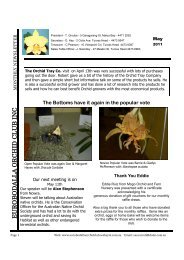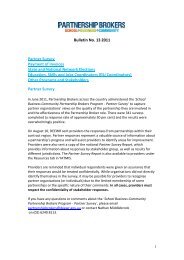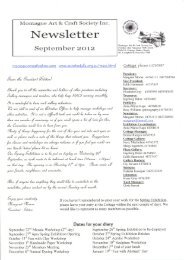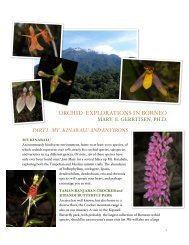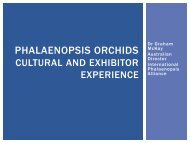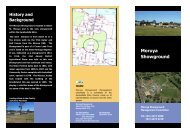Orchid Growing Substrates
Orchid Growing Substrates
Orchid Growing Substrates
Create successful ePaper yourself
Turn your PDF publications into a flip-book with our unique Google optimized e-Paper software.
years. It is clear that it was an unknown species to science, and all attempts to find more<br />
failed, as it was easy to collect such huge ferns. Hopefully they exist nearby, but it is doubtful,<br />
as the whole area around that valley had been converted to rice fields for ages, only the valley<br />
was untouched. His family is still in the tree fern business, and they commonly remove 4-7<br />
meter tall tree fern, at the rhythm of a logging truck every 2-3 days.<br />
o Some species are highly unsuitable for orchid culture for the medium or long term, whilst<br />
there are no problems in Asia with most of the stocks, there seems to be a lot of complaints<br />
from time to time arising from growers in Hawaii or Mexico, down to Brazi that some batches<br />
killed many plants.<br />
- Whilst highly appealing for orchid culture, and required for a few specific species, it appears that tree<br />
fern does not have any commercial future, though it is worth noting that it is a very long lasting, and<br />
stable, at least for some species, media.<br />
Various bark<br />
We will not mention at length the various bark, wood, pieces of cork, or slabs of teak are used to ‘mount’<br />
orchids. The composition, behavior and chemical properties can vary tremendously from one type to another.<br />
Sometimes, wood has been used in a potting mix, meranti sawdust was popular, and Norris Powell would use<br />
crushed pine cones in his Paphiopedilum potting mix. One educated guess was that the resins and some<br />
complex liposoluble compounds would degrade, and release ingredients that can promote plant growth. In a<br />
similar way, one successful grower in Belgium used sawdust from his wood manufacture to pot his<br />
odontoglossum, in clay pots. He would plant as well one plant of parsley per pot, and when the plant’s leaves<br />
would start to bend, it was time to water the orchid. He was exceedingly successful, and grew some of the<br />
best odontoglossum plants. Similarly, Charlesworth used sawdust in his later years, and in both cases it was<br />
really fresh sawdust, mixed from many species. In both cases the tap water was very alkaline and the<br />
marriage of water quality/sawdust seemed to be very successful.<br />
Types of bark<br />
Bark is the outer part of the tree. Several types of bark have been used, so we will start by some very exotic<br />
ones.<br />
Cryptomeria japonica bark<br />
o<br />
The famous ‘Cryptomoss’ from the Japanese. The texture and behavior is similar to tree fern<br />
at first, and some excellent growers use it as a potting material. It is very acidic, and usually<br />
many growers who used it had to apply some marble powder, or dolomitic limestone, to keep<br />
the pH at a proper range. It has some oils, and some compounds, that have been sometimes<br />
extracted and sold as a growth promoter. In fact, the ‘HB-101’ additive, promoted by the<br />
Japanese as a cure and grow all product, is an extract from cryptomeria bark, containing<br />
derivate of ‘resin acids’ (abietic acid, dehydroabietic acid…). Cryptomeria use is very marginal,<br />
and very rare outside of Japan, though it seems to have some qualities at first. However most<br />
Xavier Garreau de Loubresse<br />
24



